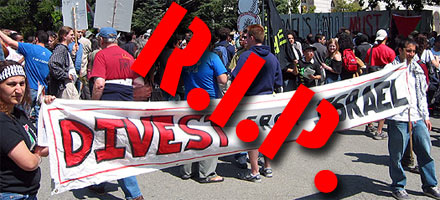

The Jerusalem Post recently wrote a well researched and exhaustive article detailing the end of the anti-Israel “Boycott, Divestment, and Sanctions” movement.
Allow me let that sink in for a second.
Yes. The Jerusalem Post wrote a good article. Wow. Good job Jon Haber! OK, so it was a guest editorial. But still…
Anyhow, apparently, the movement championed by bitter, abandoned, incontinent old women, closet anti-Semites, frustrated Marxists, naive dullards, foaming at the mouth anti-Israel activists, chic suburban limousine radicals and hateful little shits whose ex-girlfriends left them for a strapping Zionist, is now effectively dead and buried.
“BDS” (Boycott, Divestment, and Sanctions) as a tactic for anti-Israel activity and propaganda galvanized during the notorious UN World Conference against Racism in Durban in 2001 – just weeks before the 9/11 attacks. It reached a peak in 2004. But for all the energies expended by its advocates, all the headlines it has attracted for several years, and all the concern it has raised in Israel and among Israel’s supporters, it has essentially fizzled, especially with the Presbyterian Church’s recent decision to abandon divestment from Israel as church policy.
It’s a long article, but I did say it was exhaustive. So go ahead and read it. On the off chance this article goes offline in the future, I’m reproducing it in full after the bump.
The vampire’s kiss
By JON HABER
Legend (or at least Bram Stoker) posits that a vampire can only enter someone’s home if he or she is invited across the threshold. There could be no metaphor more apt for the divest-from-Israel campaigns that have proliferated among schools, unions, cities and churches in the US and Europe over the last four years.
“BDS” (Boycott, Divestment, and Sanctions) as a tactic for anti-Israel activity and propaganda galvanized during the notorious UN World Conference against Racism in Durban in 2001 – just weeks before the 9/11 attacks. It reached a peak in 2004. But for all the energies expended by its advocates, all the headlines it has attracted for several years, and all the concern it has raised in Israel and among Israel’s supporters, it has essentially fizzled, especially with the Presbyterian Church’s recent decision to abandon divestment from Israel as church policy.
A recent statement by the former president of the Muslim Student Union at UC Irvine that the recent war in Lebanon would breathe new life into the divestment movement at the university is an off-hand admission that those projects are currently suffering from a shortage of oxygen due to the failure of previous efforts. Indeed, the divest-from-Israel’s greatest detrimental impact appears to have been on the very organizations that chose to pursue this political path.
Divestment, Reincarnated
While economic warfare has been a staple of Arab-Israeli conflict since the Arab boycott of the 1920s, divestment, the latest incarnation of the money weapon, began to appear on US media radars in 2002 with a petition circulating at Harvard and MIT universities calling for both schools to “divest from Israel, and from US companies that sell arms to Israel” until various conditions were met. By the end of 2002, only 182 students, 94 staff members and 205 alumni had signed the document, yet the call for divestment emanating from members of two of America’s most prestigious schools led to similar divestment petition drives on dozens of campuses across the country.
With university divestment petitions raising awareness of this new tool for activists, America’s mainline Protestant churches began to explore divestment options. The Episcopalian Church of the USA, United Church of Christ and two regions of the United Methodist Church all passed resolutions encouraging divestment from Israel. However, it was the Presbyterian Church USA at their 2004 General Assembly, whose resolution calling for “phased, selective divestments in companies doing business in Israel,” that was central in helping divestment go from mainline to mainstream.
By 2004, divestment calls seemed to be coming from all directions: cities and towns, unions, political parties, and civic organizations representing groups as diverse as British architects (Architects and Planners for Justice in Palestine) to American lawyers (The Lawyers’ Guild). Events in the Middle East (the second Intifada and then Israeli prime minister Ariel Sharon’s response to that terrorist onslaught) were fueling anti-Israeli sentiment and activity worldwide. In addition, the groups calling for economic sanctions were already ideologically inclined to accept a narrative about the Middle East hostile to the Jewish state. Yet the fact that actions by all of these groups were coalescing around a common set of objectives points to the momentum divestment seemed to be gaining in various quarters.
This common language included a nearly identical set of targeted companies, the most prominent being equipment manufacturer Caterpillar, chosen not just because of the involvement of Caterpillar equipment in the death/martyrdom of International Solidarity Movement (ISM) activist Rachel Corrie, but also because the widespread holding of Caterpillar shares by prominent institutions effectively allowed divestment into the door of nearly any organization.
A Movement or a Tactic?
In many ways, divestment represents not so much a political “movement” or alignment, but rather a new tactic embraced by organizations already committed to propaganda on behalf of Israel’s foes. Fundamental to the many groups pushing divestment over the last five years has been the so-called “Apartheid strategy,” the desire to build a groundswell similar to the anti-Apartheid movement that targeted South Africa throughout the 1980s, this time with the Jewish state playing the role of South Africa’s white racist government.
Even those pushing divestment most vigorously understood that the short-term financial impact of divestiture on the robust Israeli economy would be minimal. But, as described again and again in university, church and other campaign communications, divestment advocates were taking a long-range view, hoping to create over time an automatic linkage in the mind of the public between Israel and Apartheid South Africa.
The organizations behind many earlier divestment drives, including the International Solidarity Movement (ISM), the Palestinian Solidarity Movement (PSM), and The Sabeel Ecumenical Liberation Theology Center, while not unknown, are certainly less prestigious than the institutions on the front lines of this decade’s divestment campaigns such as Harvard or the Presbyterian Church. This points to another cornerstone of the divestment strategy: the leveraging of institutional reputation.
The use of large, respected organizations to help small groups punch above their political weight is nothing new. Church leaders, for example, are routinely lobbied to take stands on contemporary political issues from local matters (such as crime and youth violence) to international conflicts (such as the genocide in Darfur). What separates divestment from some of these other examples is the extreme, anti-democratic lengths divestment activists have been willing to go to get such an organization into their column, and the tremendous sacrifices they demand from institutions for the “privilege” of being considered a sincere divestment advocate.
Academic Freedom
While petition drives at various universities first brought divestment into America’s political bloodstream, and garnered considerable media attention, not one school ever actually took steps to divest their considerable endowment or retirement portfolios of assets associated with the Jewish state. In fact, many educational leaders openly criticized those calling for divestment, with then Harvard president Lawrence Summers gaining the most attention in 2002 when he condemned anti-Israel activists on his campus, memorably describing them as “anti-Semitic in their effect, if not their intent.”
School leaders are often credited with derailing school divestment efforts, but the fact is that sentiment in favor of divestment never ran particularly high among students, faculty and alumni on any campus. For example, the original Harvard-MIT divestment petition was met with an anti-divestiture counter petition with 10 times as many signatories.
If American universities proved barren ground for actual divestiture (rather than media-amplified noise), academic activists did manage to chalk up an overseas victory, albeit a temporary one, with the British-based union, the Association of University Teachers (AUT).
Few outside British academic circles had ever heard of the AUT until last year, when it voted to boycott two Israeli universities on a series of what could generously be described as trumped-up charges.
As a UK-based union of university instructors and professionals, the AUT also had a “social justice” constituency that was hijacked by a group of anti-Israel activists who, through relentless maneuvering of the AUT’s Byzantine governing bureaucracy, managed to pass a resolution calling for British academics to break all ties with Bar-Ilan and Haifa Universities.
World reaction to the move was swift. Jewish groups scorned the decision while anti-Israel activists hailed it as their first academic “victory.” More important, academics worldwide condemned the AUT’s assault on intellectual freedom, and AUT members (most of whom only discovered the action their leadership had taken after decisions were made) revolted against the usurpation of their name, overturning the policy in an overwhelming vote.
Earlier this year, another British union, the National Association of Teachers in Further and Higher Education (NATFHE), passed a motion calling on individual academics to personally boycott Israeli colleagues who did not openly condemn the Israeli government. Like the AUT decision a year earlier, the NATFHE motion was taken at the behest of a small group of union activist leaders, only this time the vote was held just hours before the union dissolved itself to merge with the aforementioned AUT (which had rejected a similar boycott a few months earlier). If the original AUT vote could be considered a tragedy, the NATFHE decision (from the furtive attempt to hijack the union minutes before it disappeared to the McCarthyite call for British lecturers to impose loyalty oaths on their Israeli colleagues) most resembled farce, a much greater embarrassment to British, than Israeli, academia.
Municipal Divestment
Calls for divestment have floated around the fringes of municipal politics in cities such as Seattle, Ann Arbor and Dallas for years. However, it was in the city of Somerville, Massachusetts that divestment forces came closest to victory in the winter of 2004.
In many ways Somerville (one of the country’s most densely populated urban areas located next to Boston and Cambridge) would seem an unlikely locale for a showdown on Middle East politics. The city has small Jewish, Arab and Muslim communities, none of which are particularly politically active. While activists claimed that the make-up of the city’s retirement fund portfolio (which included not just Caterpillar shares, but also investments in Israel Bonds) was the reason for their local campaign, the choice of Somerville had more to do with the dynamics of the anti-Israel activist community in the Boston area.
Due to the cosmopolitan nature of the region and the availability of large amounts of student activist “labor,” Boston has always been home to a wide variety of both pro – and anti – Israel organizations. Unlike their more stable nemeses (such as the Boston-based CAMERA and David Project), local groups antagonistic to the Jewish state tend to be fluid, frequently forming, splitting and reorganizing based on changes in Middle East politics (most recently Islamist trends) or around new tactics such as divestment.
Divestment was spearheaded by a group named the Somerville Divestment Project (SDP). Claiming to be a local, grassroots organization that had mobilized in reaction to the city’s municipal investment choices, members of the organization included familiar names from Boston, Cambridge and area suburbs who had been involved with various anti-Israel campaigns (including petition drives, film and lecture series, and consulate and Israel Independence Day protests) for decades.
Meeting behind closed doors with Somerville’s aldermen (the city’s 11-person legislature, a group with a history of taking stands on national and international issues beyond their purview such as Burma, Sudan and the USA Patriot Act) for over a year, the SDP managed to convince the majority of legislators that the Arab-Israeli crisis neatly fit the Burma/Sudan template as an international human rights crisis with a simple storyline and clear villains and victims. Information that might have laid blame on the crisis taking place in the region (including the deaths of over 1,000 Israelis from terror bombing) on anyone other than Israel was marginalized in the discussion.
In late October of 2004, the Board of Aldermen was about to vote in favor of a non-binding resolution recommending that the independent retirement board divest holdings (including stocks and Israel Bonds) that the SDP had identified as representing “investment” in the Israeli side of the Arab-Israeli conflict. It was only when two legislators insisted that the final vote be deferred until public hearings were held that the citizens of Somerville found out what had almost been done in their name.
The ensuing controversy, covered by worldwide media, brought Boston’s Israel Consul General into hearings that proved to be the most raucous in the city’s history, with area activists on both sides of the issue flooding city hall in a series of meetings between early November and early December of 2004. While opposition never had the chance to fully organize, the scope of the controversy easily convinced the city’s aldermen that the storyline the SDP had been feeding them for months was an inaccurate oversimplification designed to minimize the hugely controversial nature of what they were being asked to do. Once the complexity of the Middle East conflict was made clear, and the scope of the controversy understood, aldermen reversed their original positions, voting unanimously to kill the measure.
Divestment raised its head again in Somerville last year, when the SDP decided to take its case “to the people” via a voter petition drive to get divestment onto the 2005 electoral ballot. This time, though, opponents of divestment had the chance to organize a counter campaign. Just as significantly, the SDP had developed fissures after its 2004 defeat, splitting and reforming under a much more radical leadership that hit the streets with a campaign so harsh, abusive and even anti-Semitic, that it alienated many of those who had once supported the organization.
The loss of experienced political operatives led to a series of blunders, notably a refusal to follow the rules set forth by the city on the nature and timing of legal petitioning activity. Despite attempts to sue the city, divestment never made it onto the 2005 ballot. Although it is unknown what would have happened had the issue reached voters, phone-banking efforts by divestment opponents during the summer of ’05 found sentiment running a familiar 10 to one against divestiture.
Divestment proponents are currently attempting to make use of more lenient district requirements to get two anti-Israel measures onto a local ballot in November 2006. Yet the further their efforts are separated from the government endorsement they nearly received in 2004, the more the significance of their activity fades to resemble the petition-driven anti-Israel activism that has been background noise in the Boston area for decades.
Bearing Witness
By far, the US Presbyterian Church (PCUSA) had been the jewel in the crown of the divestment movement. Like divestment votes in the AUT and Somerville, the church’s divestment decisions were made by a small group that acted with minimal input from members. Unlike these other institutions, however, this small group was not a radical fringe, but rather included members from the church’s top leadership.
In contrast to more hierarchical religious institutions, the Presbyterians have a representational structure operating at the level of Presbyteries consisting of one or more churches organized geographically. Ostensibly, decisions on church policy emanate from the Presbytery-level “grass roots” that submit resolutions, called “Overtures.” These are voted on by representatives of all Presbyteries at a General Assembly held every two years.
The church currently faces a pair of linked institutional crises: a dwindling membership (which has fallen by almost half in the last four decades) paired with growing centralization of power within a church bureaucracy that has assumed quasi-executive authority. Church management of several billion dollars in assets (including property and huge investment and retirement funds) created the need for a large, full-time, paid professional church staff, located in Louisville Kentucky. Over the years, Louisville has shown an increasing tendency to manage denominational issues (including theological and political disputes) from the top.
This bureaucracy’s hostility to the Jewish state has been manifest for close to two decades, and has included several pronouncements that effectively lay blame for all problems in the Middle East at Israel’s doorstep (including both Arab suffering and Israeli suffering born from occupation-created Palestinian “desperation”). The Presbyterian News Service (PNS) is uniformly uninterested in or hostile to Israeli versions of events, and much of the theological language used to describe the conflict has been lifted from the church’s partners in Middle East “peacemaking,” the Sabeel Ecumenical Liberation Theology Center, a radical Palestinian Christian group behind many church divestment programs.
Divestment was one of many Overtures handled in the last hours of the PCUSA’s 2004 General Assembly. Part of a string of resolutions that, among other things, condemned Israel’s security barrier and called for an end to “the occupation”(described as the root cause of all violence in the region), divestment seemed a natural extension to church policies of taking stands on Middle East issues and using their investments as leverage on political and social issues. Given this backdrop, church leaders were unprepared for the controversy their divestment resolution would cause. Within days of that vote, however, divestment champions were traveling the globe broadcasting their success and using the PCUSA resolution to convince other churches that they should join their Presbyterian brothers in punishing the alleged crimes of “Apartheid Israel.” At the same time, Jewish leaders let it be known that inter-faith dialogue could not continue with divestment on the table.
The church’s hostility to the Jewish state led to a spate of negative publicity. Press coverage became particularly embarrassing after Al-Manar, Hizbullah’s satellite television network, revealed that Presbyterian groups, including representatives from the national denomination’s powerful Advisory Committee on Social Witness Policy (ACSWP), had met with the Lebanese terrorist organization on several occasions. A quote from ACSWP member Ronald Stone stating that “As an elder of our church, I’d like to say that according to my recent experience, relations and conversations with Islamic leaders are a lot easier than dealings and dialogue with Jewish leaders,” led to condemnation from several quarters, including the US Congress.
Although outsiders played a role in lobbying PCUSA between 2004 and the 2006, it was the disaffection of numerous church members, spurred on by bad publicity related to events like the meeting with Hizbullah, that helped see divestment unseated at the June 2006 General Assembly meeting in Birmingham, Alabama.
Polls indicated that support for divestment dissipated quickly the closer one got to the pews, and this year’s meeting featured dozens of Overtures on the Middle East, most calling for divestment to be overturned. While the church hierarchy worked hard to try to get decisions on this issue deferred and kept in the hands of church professionals, a membership revolt led to the overturning of divestment within PCUSA which was approved by 95 percent of voters.
Just as PCUSA’s 2004 decisions blazed the trail for other churches to pass their own divestment resolutions, so the Presbyterians’ 2006 reversal on divestment has led to an abandonment of the tactic by other churches, including the Anglicans and United Church of Canada (UCC). The UCC case is particularly telling since that group’s General Council rejected specific economic targeting of Israel just as the war in Lebanon was in full force. Even with that fighting as backdrop, UCC not only walked away from Israel-specific divestment, but also criticized Middle East countries that do not accept Israel’s right to exist, a significant turnaround for what had been one of Israel’s harshest critics among mainline Protestant organizations.
Common Threads
In every case where divestment has met with success, it has been the result of a small group of dedicated activists willing to use any tactic, including subverting democratic procedures, to turn a respected organization into an ally. And whenever those decisions could be subjected to democratic input, those victories have been reversed, preventing divestment champions from gaining the momentum needed to make their Apartheid strategy self-sustaining.
When divestment has been democratically defeated, it has never been by a close margin, but by lopsided majorities of 10-20 to 1. It needs to be remembered that these overwhelming numbers do not represent a liberal-conservative split, such as America’s supposed “Red-Blue” divide, for divestment’s few successes have been entirely within self-identified progressive institutions. If the subject somehow became the basis for a nationwide survey, sentiment in support of divestment from Israel would in all likelihood barely be noticeable.
Also, whenever divestment has gained traction (in political maneuvering more resembling coups than revolutions, much less democratic processes), organizations that have embraced the divestment agenda have been asked to place their most sacred assets on the altar. In the case of the AUT, it was academic freedom. In the case of the Presbyterian Church, it was Christian witness. This is no accident, for someone making a political choice can always change his or her mind. But an institution placing its most valued possession, its reputation, on the line will find it that much more difficult to pull back from the brink.
While it is tempting to look at divestment in retreat as a simple good-news story, there are important lessons to be learned from the struggles of the last four years, especially in light of new violence in Gaza and Lebanon and efforts by Israel’s foes in Europe and the US to use unfolding events to re-stoke their movement.
First, the shallow support for divestment, even among liberal-minded institutions, demonstrates that grassroots citizens and group members are not inclined to see their institutions subverted for narrow political purposes. It would be a stretch to say that a Zionist heart beats in the breast of the average Presbyterian, British university lecturer or Somerville citizen. However, common people continue to show more good sense than their leaders, at least with regard to protecting their organizations from cynical manipulation.
Second, divestment’s repeated defeats demonstrate the potentially permanent impact of Israel’s supporters taking a stand and saying “no more.” By way of example, more than ten years ago James Zogby’s Arab Anti-Discrimination Committee (AADC) had achieved some success in getting anti-Israel language written into the platforms of Democratic state committees in several US states. It was in Massachusetts that their efforts met a wall of resistance by an organized Jewish community, much as divestment faced its Waterloo in the city of Somerville. This effort broke the critical momentum AADC had achieved and, within a year, language critical of Israel was removed from state party platforms.
It may be that divestment, with its call for economic boycott echoing dark chapters in Jewish history, was odious enough to unite individuals and groups with widely varying positions on the Middle East. But especially in light of current events, the power of unified defiance should not be underestimated.
Finally, groups contemplating an embrace of divestment as their means of doing something about the crisis in the Middle East should look at what this position has cost other groups that have taken this controversial step. In England, a newly merged teacher union faces ongoing internal battles over overt and covert academic boycotts, and diminishing public sympathy for an organization that claims to represent academic freedom. After two years of cynical maneuvering, the leadership of PCUSA is regarded with suspicion by its own members, just as those outside the church are asking if it merits the moral leadership it claims for itself.
To see the degenerating effects of divestment at its fullest, one need only look at the Green Party in the US, now so heavily infiltrated by Islamist radicals that its main raison d’etre seems to be battling over “190,” the party’s own impotent divestment resolution. Once again, this resolution was made national party policy at the eleventh hour by radical members, with little input from party members and in contravention to party rules (including requirements to consult with other national Green parties, such as the one in Israel). With members leaving the party in droves over the issue, and Green candidates struggling with the 190 albatross in mainstream political races, a party once able to play spoiler in a national election may fully self-immolate long before it can even reach America’s graveyard of failed third parties.
It may be that the Lebanon crisis will breathe new life into the struggling divestment movement. But at the time of this writing, even the most vocal institutional critics of Israel (such as the mainline Protestant churches) show no immediate interest in revisiting the campaign, no interest, that is, in inviting the vampire back across the threshold.
Jon Haber is a Massachusetts writer and the creator of the anti-divestment activist Web sites www.somervilleMEjustice.com and www.bearing-witness.org.
- Hawk Tuah Girl Haliey Welch is Not Jewish. Probably. - 8/9/2024
- Jews Blessed by their High Priests - 10/14/2022
- Foolproof Mufletta Recipe & Muflettapalooza / Mimouna Invite! - 3/26/2021






Nice article inspiring thanks. ????????????? ????????????? b??????? ?????av????
Title
[…]always a large fan of linking to bloggers that I adore but do not get a lot of link adore from[…]
Title
[…]one of our visitors a short while ago advised the following website[…]
Title
[…]below you will find the link to some websites that we think you need to visit[…]
Title
[…]here are some links to web pages that we link to because we assume they may be really worth visiting[…]
Title
[…]Here are a number of the web-sites we suggest for our visitors[…]
Title
[…]always a huge fan of linking to bloggers that I love but don’t get a whole lot of link love from[…]
Thank you for every other informative blog.
Great post thank you. php shell , php shell archive , php shell download , php shell indir , shell indir , web shell indir , shell download
Title
[…]Here are a few of the internet sites we suggest for our visitors[…]
Title
[…]please go to the websites we adhere to, which includes this a single, as it represents our picks in the web[…]
uluslararas? evden eve nakliyat
Thank you for every other informative blog.
Title
[…]Every when inside a when we decide on blogs that we read. Listed beneath are the most current web-sites that we opt for […]
Title
[…]please check out the internet sites we comply with, including this 1, as it represents our picks in the web[…]
fake sms kodu
Thank you for great content.
Title
[…]the time to study or stop by the content or internet sites we’ve linked to beneath the[…]
https://edenarcade.org
An impressive share! I have just forwarded this onto a colleague who was doing a little research on this. And he in fact bought me breakfast because I found it for him… lol. So let me reword this…. Thank YOU for the meal!! But yeah, thanx for spend…
Title
[…]Sites of interest we have a link to[…]
Thank you for every other informative blog.
Title
[…]the time to study or stop by the subject material or web-sites we’ve linked to below the[…]
Title
[…]the time to read or visit the material or web-sites we have linked to beneath the[…]
https://wg89.vip/
I must thank you for the efforts you have put in writing this blog. I am hoping to see the same high-grade blog posts from you in the future as well. In fact, your creative writing abilities has inspired me to get my own blog now
Let me show you the most professional locksmith in London and Surroundings!
osmaneli escort bayan sitesi telefon numaras?
Lately I’ve heard from some (unrelated) people out of the blue that they’re boycotting Israel products like oranges, vegetables, some vegetarian food products and so on (whatever it is that Israel produces anyway). They just blurted it out when discussion turned into Lebanon, vegetables, food, shopping or such things. Mostly it seemed to be agricultural products.
They’re not influenced by any movement which would tell them to “now stop buying this and that”, they merely see things in the news, television, in the papers and despise what’s happening and use the only tool they have at hand to make a difference (their buying power).
Um, the Jerusalem Post has many excellent articles and editorials.
Anyway, this article is a tad optimistic.